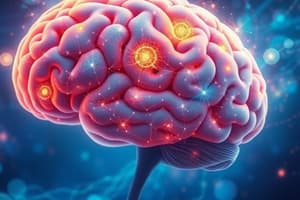Podcast
Questions and Answers
What is the primary function of the human brain?
What is the primary function of the human brain?
- Maintaining body temperature
- Interacting with the world around us (correct)
- Regulating heartbeat
- Controlling bodily functions like digestion
What role do synapses play in the brain?
What role do synapses play in the brain?
- Regulating heartbeat
- Passing signals between nerve cells (correct)
- Supporting and protecting neuron cell bodies
- Converting light into electrical signals
Which part of the eye is responsible for converting visible light into electrical signals?
Which part of the eye is responsible for converting visible light into electrical signals?
- Retina (correct)
- Lens
- Eardrum
- Cornea
How do sound waves enter the ear for processing?
How do sound waves enter the ear for processing?
What are glial cells in the brain primarily responsible for?
What are glial cells in the brain primarily responsible for?
Which of the following is NOT a main sense involved in sensory processing according to the text?
Which of the following is NOT a main sense involved in sensory processing according to the text?
Which part of the brain is primarily responsible for controlling emotions, memory, and instinctual behavior?
Which part of the brain is primarily responsible for controlling emotions, memory, and instinctual behavior?
Where are taste buds located to detect chemical substances like salt, sweetness, sourness, and bitterness?
Where are taste buds located to detect chemical substances like salt, sweetness, sourness, and bitterness?
Which part of the brain is involved in decision-making, problem-solving, and social behavior?
Which part of the brain is involved in decision-making, problem-solving, and social behavior?
What is the function of the medulla oblongata in the brain?
What is the function of the medulla oblongata in the brain?
Which brain region converts vibrations in the inner ear's fluid-filled cochlea into electrical signals?
Which brain region converts vibrations in the inner ear's fluid-filled cochlea into electrical signals?
During what life stage does the brain undergo rapid growth followed by refinement and specialization?
During what life stage does the brain undergo rapid growth followed by refinement and specialization?
Flashcards are hidden until you start studying
Study Notes
Brain Functions
Brains are complex organs responsible for many essential life processes. They play significant roles in controlling bodily functions such as breathing, regulating heartbeat, maintaining body temperature and blood pressure, digestion, immune response, and more. However, their primary function is to control how we think, feel, remember, walk, talk, and interact with the world around us.
The human brain consists of approximately 86 billion neurons (nerve cells) and glial cells, which support and protect these specialized cells. Neuron cell bodies receive information from other cells through synapses, the junction between two nerve cells where signals pass from one cell to another. These connections allow the brain to process and respond to vast amounts of sensory data from within the body and its external environment.
Sensory Processing
Sensory processing involves five main senses: sight, sound, touch, taste, and smell. Each sense is associated with specific groups of neurons known as receptors, which are sensitive to different stimuli:
-
Sight: Light enters the eye's cornea and passes through the lens to focus on the retina, a light-sensitive layer of tissue lining the back of the eye. Photoreceptor cells - rods and cones - in the retina convert visible light into electrical signals, which can then be interpreted as images by the brain.
-
Sound: Sound waves enter the ear and vibrate the eardrum, which in turn causes the tiny bones of the middle ear to move. These movements create vibrations in the inner ear's fluid-filled cochlea, where hair cells convert these vibrations into electrical signals.
-
Touch: Tactile receptors in the skin sense touch and pressure, sending signals to the brain via the nervous system.
-
Taste: Taste buds on the tongue and other areas of the mouth detect chemical substances, such as salt, sweetness, sourness, and bitterness.
-
Smell: Receptors in the nose detect chemical odors, which are then sent to the olfactory bulb, a small area at the base of the brain, for interpretation.
Motor Functions
Motor functions involve the control of voluntary muscle movements and the coordination of these movements to perform tasks. This is achieved through the medulla oblongata, the brainstem region responsible for regulating vital body functions. The motor cortex, located in the brain's frontal lobe, controls voluntary movements.
Emotional and Cognitive Functions
The brain's emotional and cognitive functions are primarily located in the cerebral cortex, the outer layer of the brain. The limbic system, a group of structures in the brain, is responsible for controlling emotions, memory, and instinctual behavior. The prefrontal cortex, a part of the cerebral cortex, is involved in decision-making, problem-solving, and social behavior.
Brain Development
Brain development starts in the womb and continues throughout life. The brain undergoes rapid growth during infancy and early childhood, followed by a period of refinement and specialization during adolescence and young adulthood. The brain's development is influenced by genetics, environment, and experiences, shaping its structure, function, and resilience.
In conclusion, the brain is a complex organ that plays a crucial role in controlling various bodily functions and facilitating our interactions with the world around us. Understanding its functions and development can help us appreciate its importance in our lives and guide efforts to support its health and well-being.
Studying That Suits You
Use AI to generate personalized quizzes and flashcards to suit your learning preferences.




